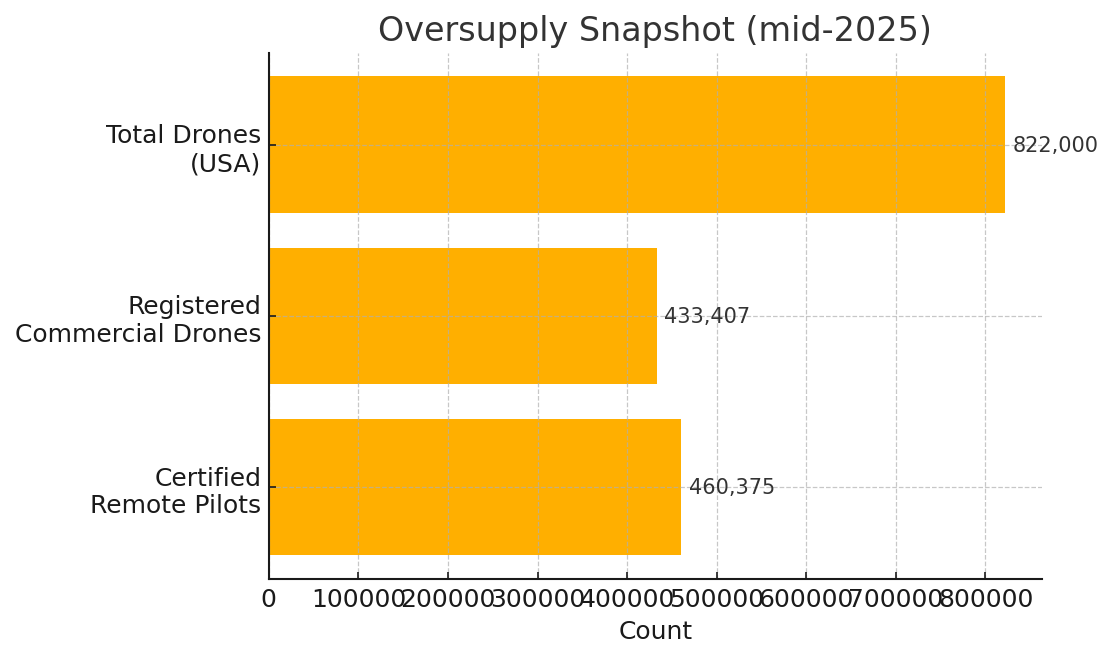The 2025 Guide to Going Beyond Part 107
Part 107 opened the door. This guide shows how to step through it—by layering real‑world skills, safety leadership, and standards‑based credentials that employers value.
Part 107 is a Launchpad,
Not a Career Plan
When the FAA introduced Part 107 in 2016, it opened the door to commercial drone operations—no expensive flight school or Section 333 exemptions required. Study, pass a 60‑question knowledge test, and you can fly commercially.
By 2025, the industry evolved. There are now more certificated remote pilots than registered commercial drones. Part 107 remains essential, but it’s no longer a differentiator—it’s the baseline. Building a career today means going beyond the written test to demonstrate readiness and professionalism.
This Guide Will:
Part 107 in 3 Minutes:
Refresher & Reality Check
Timeline
The Oversupply Problem — Too Many Pilots?
There are now more licensed pilots than commercial drones to fly. A Part 107 certificate alone no longer guarantees a premium job. With so many “107‑only” pilots, basic tasks are commoditized.
Example: A utility will pay far more for a pilot who can perform a BVLOS powerline inspection with formal risk assessments than one limited to standard daylight VLOS photography.

Flight Proficiency
Part 107 has no hands‑on flight test. A pilot may ace airspace questions but struggle with precision maneuvers. Solution: Employers increasingly use practical flight screenings and task‑based evaluations.
Safety & Risk Management
Rules alone don’t build safety culture. Concepts like crew resource management and SMS aren’t taught by Part 107. Solution: Add formal safety and human‑factors training.
Mission Planning & Data Management
Part 107 doesn’t teach end‑to‑end mission workflows, data QA, or compliance. Solution: Training like VSO Ground/Flight builds planning, collection, and data handling skills.
Advanced Ops (BVLOS & Tech)
BVLOS and autonomy demand detect‑and‑avoid, waivers, and new rules—beyond Part 107. Solution: Pursue BVLOS‑readiness and stay current on evolving FAA guidance.
Safety Level Certifications
Progressive competencies in UAS systems, maintenance, risk management, and advanced operations.
- sUAS Safety Level I & II — foundational systems & safety.
- VLOS Operations — VSO Ground/Flight for standard ops.
- Advanced Unmanned Safety I & II — risk management, human factors, SMS.
- UAS Cybersecurity — (if available) broaden your skill set.
Specialized Endorsements & Skills
Targeted skills that set you apart in specific domains.
- BVLOS Readiness — prepare for beyond‑visual‑line operations.
- Thermal Imaging — IR inspections for energy & public safety.
- Mapping & Surveying — GIS and photogrammetry workflows.
- Sector‑Specific Training — public safety, utilities, agriculture, inspections.
Ready to Go Beyond Part 107?
Explore USI’s full training pathway and elevate your credentials today.
